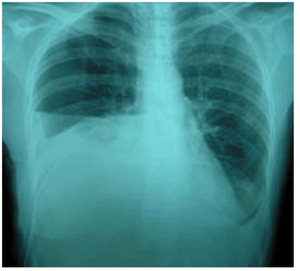Urinothorax
Urinothorax (pl. urinothoraces) means urine in the fluid-filled cavity that surrounds the lungs.[1] It is an extremely rare cause of pleural effusion. It is secondary to obstructive uropathy whereby urine forms a collection in the pleural cavity. The urine arrives in the pleural space either retroperitoneally (under the peritoneum) under the posterior diaphragm, or via the retro peritoneal lymphatics. It remains a rare, possibly under-diagnosed, differential in the case of transitive pleural effusion. Respiratory symptoms are usually mild.[2] Handa et al., described 47 cases between 1967 and 2007, noting that it was more prevalent in males, generally ipsilateral to the obstruction, and in most of the cases it is relieved by clearance of the obstruction.[3]
| Urinothorax | |
|---|---|
 | |
| Bilateral pleural effusions turning out to be urinothorax. | |
| Specialty | Pulmonology |
| Symptoms | Similar to pleural effusion |
| Causes | obstruction |
Symptoms
The defining characteristics of people affected by urinothorax are poorly defined. Symptoms include difficulty breathing, abdominal pain, chest pain, and reduced urination.[4]
Causes
It is either caused by an obstruction (obstructive uropathy), caused by trauma, or iatrogenic. Traumatic cases tend to occur on one side, while obstructive cases tend to be bilateral.[5]
Diagnosis
The pleural fluid is most often straw-colored, and it has a distinct smell like ammonia. Primary factors for diagnosing urinothorax include low protein and high LDH content.[6] Low glucose levels and acidity are also described, but not reliable ways to diagnose or rule out urinothorax.[5]
The most important chemical diagnostic factor of the fluid is that the ratio of creatinine to serum is more than 1 and usually more than 10.[6]
Treatment
Treatment mainly consists of relieving urinary obstruction if it is present. If respiratory symptoms are minimal or nonexistent, thoracentesis may not be needed, as urinothoraces can resolve on their own in some cases after.[5]
References
- Salcedo, Jose R. (April 1986). "Urinothorax: Report of 4 Cases and Review of the Literature". Journal of Urology. 135 (4): 805–808. doi:10.1016/S0022-5347(17)45862-9. PMID 3514964.
- Wunderle, Kathryn; Kim, Suil; Chiovaro, Joseph (15 March 2017). "Urinothorax: A Rare Case of Pleural Effusion". Journal of General Internal Medicine. 32 (9): 1058–1059. doi:10.1007/s11606-017-4032-z. PMC 5570734. PMID 28299602.
- Handa, A; Agarwal, R; Aggarwal, AN (November 2007). "Urinothorax: an unusual cause of pleural effusion" (PDF). Singapore Medical Journal. 48 (11): e289-92. PMID 17975679.
- Toubes, María E.; Lama, Adriana; Ferreiro, Lucía; Golpe, Antonio; Álvarez-Dobaño, José M.; González-Barcala, Francisco J.; San José, Esther; Rodríguez-Núñez, Nuria; Rábade, Carlos; Lourido, Tamara; Valdés, Luis (May 2017). "Urinothorax: a systematic review". Journal of Thoracic Disease. 9 (5): 1209–1218. doi:10.21037/jtd.2017.04.22. PMC 5465116. PMID 28616270.
- Wei, Benjamin; Takayama, Hiroo; Bacchetta, Matthew D. (2009). "Urinothorax: An uncommon cause of pleural effusion". Respiratory Medicine CME. 2 (4): 179–180. doi:10.1016/j.rmedc.2009.01.009.
- Chandra, Alka; Pathak, Amrendra; Kapur, Anu; Russia, Neha; Bhasin, Nikhil (2014). "Urinothorax: A rare cause of severe respiratory distress". Indian Journal of Critical Care Medicine. 18 (5): 320–322. doi:10.4103/0972-5229.132501. PMC 4047695. PMID 24914262.